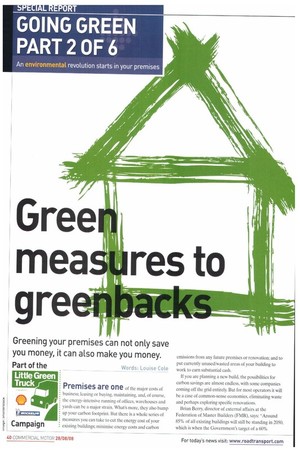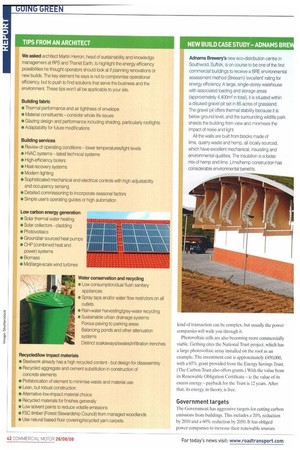Gree mea gre
Page 40

Page 41

Page 42

Page 43

If you've noticed an error in this article please click here to report it so we can fix it.
Greening your premises can not only save you money, it can also make you money.
Part of the Words: Louise Cote Premises are one of the major costs of business; leasing or buying, maintaining, and, of course, the energy-intensive running of offices, warehouses and yards can be a major strain. What's more, they also bump up your carbon footprint But there is a whole series of measures you can take to cut the energy cost of your existing buildings; minimise energy costs and carbon emissions from any future premises or renovation; and to put currently unused/wasted areas of your building to work to earn substantial cash.
If you are planning a new build, the possibilities for carbon savings are almost endless, with some companies coming off the grid entirely. But for most operators it will be a case of common-sense economies, eliminating waste and perhaps exploring specific renovations.
Brian Berry, director of external affairs at the Federation of Master Builders (FMB), says: "Around 85% of all existing buildings will still be standing in 2050, which is when the Government's target of a 60% reduction in carbon output becomes a reality and this target may go up to 80% if the Climate Change Bill takes effect. The test is to make existing buildings more energy efficient."
There are a handful of basic steps that most companies can take at all premises that will significantly cut carbon emissions and healing bills.
• Insulation Bill Gething, partner at architect Feilden Clegg Bradley Studios and the Royal Institute of Architects (RIBA) president's adviser on sustainability, says: "I would advise companies to be wary of gizmos, such as new materials, unless they have proved themselves. The most important thing you can do is save energy and the old boring standbys like insulation are still very important."
• Air-con, windows and heating Berry also recommends overhauling inefficient heating systems and using passive heating and ventilation wherever possible in other words, turn off the air-con and open your windows. Roof lights are also important in saving electricity.
• Decor Some measures are ridiculously simple. but will have astounding effects. "Paint rooms a lighter shade," says Berry. "A report for the Royal Institute of Chartered Surveyors in 2007 shows this can save 5% of energy because people need or feel they need less light."
Saving energy must become part of company culture, just as saving fuel would be. "Have a simple, clear policy,says Berry -A checklist is useful."
Hindrances to the market
There are a couple of major obstacles to the ease with which companies can make existing buildings more energy efficient. One is that there is no accepted or Government-set standard for improvement, unlike the regulations that govern energy efficiency in new builds. The other is that widespread demand is still lacking.
Berry says: "While some builders are entrepreneurial and see chances for green developments, many are very traditional in the way they approach jobs and will continue to be so until there is sufficient demand. It is essential that customers challenge their builders to con-le up with innovative solutions."
The FMB thinks the Government should be offering more support to create demand in this market. One of its lobbying platforms is a cut in VAT on repair and maintenance work from 17.5% to 5%. Another idea is to have energy efficiency work offset from business rates. With energy prices climbing, these issues may be worth bringing to your MP's attention.
Earning money from energy
Switching energy supplier has long been a hot topic in consumer markets, where easy price comparison and open contracts facilitate easy moves. It is much harder to compare energy prices for commercial customers since prices tend to be privately quoted and contracts may be longer term. However, if you are in a position to shop around, it's worth looking at green energy suppliers. Ecotricity, Greenenergy and Scottish Hydro-Electric are all examples of sustainable power firms. Although their offerings may not be cheaper now, if energy prices continue to climb, they may be cheaper in the long run.
But the real trick is to use roof space on warehouses and offices or overspill parking land as a micro-generation site. Gething says: "Warehouses as energy generators is a very interesting area. For most buildings this isn't worthwhile but large roof spaces make it viable. Companies should be able to do much better than just generate their own energy they can sell the excess."
Companies such as Sainsbury's, Ford and Michelin have already partnered with energy companies at key sites to allow a wind turbine to be erected. All these are with Ecotricity's Merchant Wind Power project (www.econicity.co.uldacrobat/NEWP.pdf). Ecotricity assesses the site, pays all the capital costs of erecting a wind turbine and handles all maintenance and operational issues. The outcome is cheaper than conventional electricity prices guaranteed for 30 years.
Greenenergy will buy any surplus energy you have 74111 from a microgeneration plant. The bureaucracy of this kind of transaction can be complex, but usually the power companies will walk you through it.
Photovoltaic cells are also becoming more commercially viable. Gething cites the National Trust project, which has a large photovoltaic array installed on the roof as an example. The investment cost is approximately £450,000, with a 65% grant provided from the Energy Savings Trust. (The Carbon Trust also offers grants.) With the value from its Renewable Obligation Certificate ie the value of its excess energy payback for the Trust is 12 years. After that, its energy, in theory, is free.
Government targets
The Government has aggressive targets for cutting carbon emissions from buildings. This includes a 20% reduction by 2010 and a 60% reduction by 2050. It has obliged power companies to increase their renewable sources every year, and this includes buying power from microgeneration plants. So far, the obligations all extend to the suppliers of energy and construction, and not to customers. For more information on guidelines and targets, see the UK Green Building Council report on 'Zero carbon in non-domestic buildings', which is available at www.comnuinities.gov.tikidocuments/ planningandbuilding/pdficarbonreductionsreportpdf By 2016, all new housing will have to be zero carbon, and communities and local government will be consulting later this year on extending this zero-carbon obligation to new non-domestic buildings by 2019. While it is accepted that making all existing buildings zero carbon is too difficult a feat, we may see an increased amount of offsetting expected from commercial energy users. For instance, it's likely new builds will not all be able to generate their own energy. Therefore, their owners may be expected to invest appropriately in renewable energy elsewhere. This may be extended to existing buildings.
One way or another, between increased legislation and soaring energy prices, no business will be able to ignore renewable energy and energy efficiency. •




































































































































































